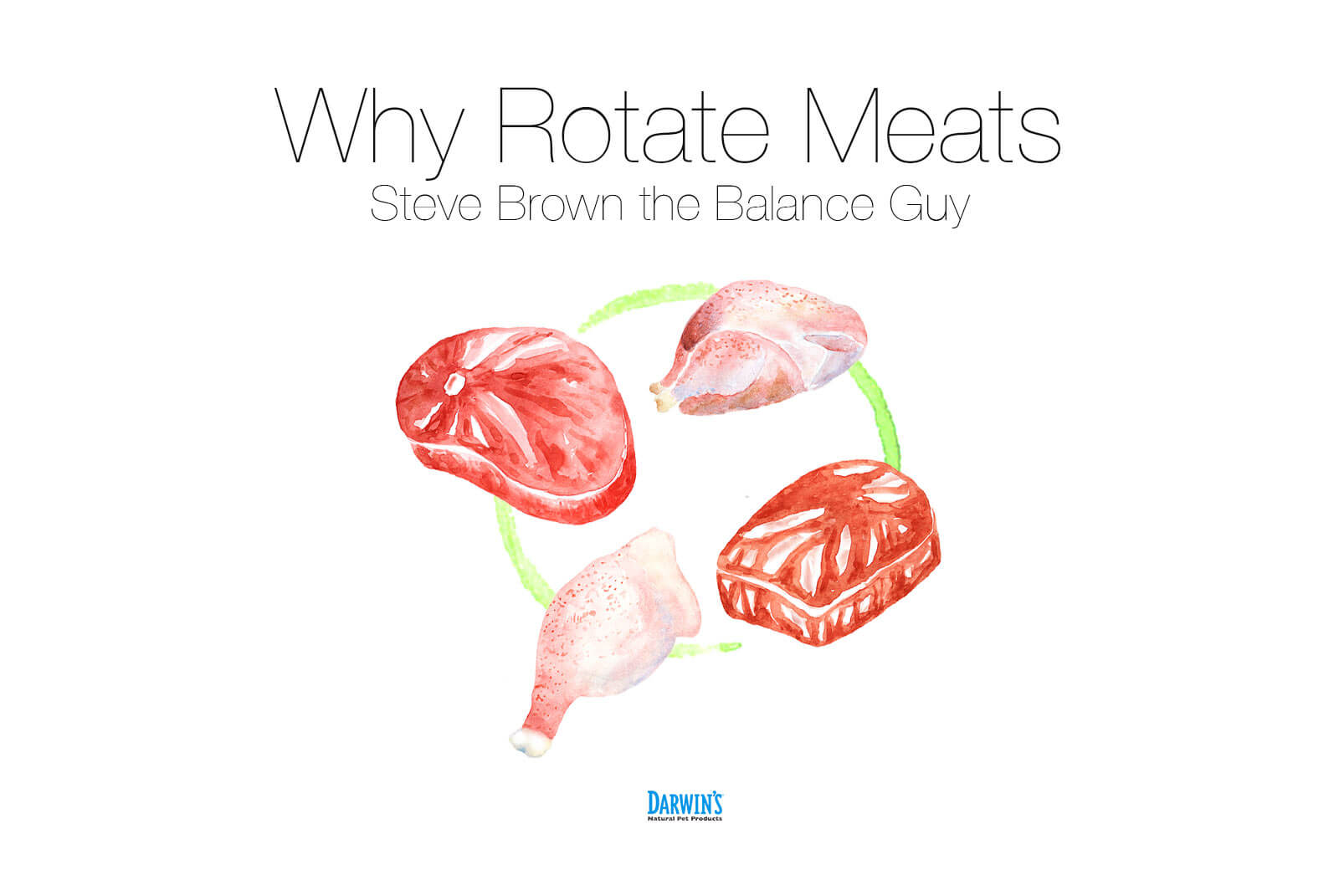Why Rotate Dog Food
7/12/16


Why switch dog foods?
-rotating meats provides better nutrition-
Rotating poultry with ruminant meats provides a better balance of nutrients than either just poultry or just ruminant meats provide on their own. For those who pay very close attention to details, this saves the homemade diet maker money by allowing the use of inexpensive, higher-fat, meats.
Throughout this series I recommend rotating poultry, such as chicken, duck, quail and turkey, and ruminants, which includes cattle, sheep, and deer. Here is why.
Switching meat sources improves the balance of:
- fatty acids
- minerals
- vitamins
- amino acids
Improved balances mean better nutrition.
Better Fats by switching foods –
The working title of my last book is, “Better Fats, Better Dogs”, because the dog and cat are the fats they eat more than any other nutrient. (“Better Fats, Better Dogs” is not published yet.) Rotating ruminant and poultry provides a better fat balance.
Beef is high in saturated fats, and low, far below minimum standards, in the essential polyunsaturated fats, including LA, linoleic acid, the first fatty acid deemed essential for dogs. If one feeds just ruminant meats, one needs to add a source of LA, often from vegetable fats or seeds (for instance, hemp seed to improve balance of fats in beef foods). On the other hand, chicken is high in LA, indeed, fatty chicken diets often exceed maximum recommendations, which can be pro-inflammatory.
If one rotates, a day or two of beef, low in LA, and then a day or two of chicken, high in LA, the LA amounts even out; meeting all standards. To save a little money, one can rotate lean beef foods, and fattier (but not high fat) less expensive, chicken parts. But, if one is not rotating, one has to use leaner chicken parts.
Mineral Balance improves when you rotate meals –
Beef and chicken meats provide different levels of minerals. For example, beef liver contains about 10 times more copper than chicken liver.
- Feed a meal of chicken, with chicken liver, and the diet will probably fall short of minimum recommendations for copper.
- Feed a meal of beef, with more than 5% beef liver, and the food will be copper-rich, with perhaps more copper than is advisable on a continual basis.
Rotation solves the problems. If you take a look at the nutrient tables in my “Focus On Nutrients Series” you’ll notice some big differences.(Series is listed below.)
Amino Acid Balance increases –
As most of us know, turkey and chicken are high in tryptophan, an essential amino acid (proteins consists of long chains of amino acids). On the other hand, beef is low in tryptophan. Some beef diets, using moderately fatty beef, fall short of minimum recommendations for tryptophan. For dogs, lack of tryptophan in high protein diets may lead to aggressive behavior[i]. Lean (skin and separable fat removed) chicken and turkey breast have about 2.5g of tryptophan per 1000 kcal, while the equivalent leanness beef has about 0.8g of tryptophan per 1000 kcal. It’s important to rotate
Vitamin Balance is achieved when foods are switched regularly –
I’ll use vitamin B12 as an example-
Chicken has more tryptophan than beef, however, beef has more vitamin B12 than chicken. I’ve seen recipes for chicken and vegetable diets with no organ meats.These diets lack vitamin B12. While typical lean dark chicken meat has just 3.9mcg (micrograms,1 millionth of a gram) per 1000 kcal;a moderately fatty beef, 85% lean, has 104mcg per 1000kcal.
Remember to rotate!
This ends Part 1 of Steve Brown’s Focus on Nutrients. Part 2 will be out shortly!
previous chapters:
– The Dog’s Ancestral Diet – Focus on Nutrients Part 1
– Vegetables for Dogs – Focus on Nutrients Part 1
– “Complete ans Balanced” What does it mean to pet food? – Focus on Nutrients Part 1
– Buying Raw Pet Food – Focus on Nutrients Part 1
– Bringing Out the full Health Potential of Your Dog – Focus on Nutrients Part 1
– Steve Brown’s Introduction to Focus On Nutrients Part 1
[i] http://ivcjournal.com/can-high-fat-beef-based-raw-diets-lead-to-behavioral-issues-and-aggression-in-some-dogs/
 Steve Brown is a dog food formulator, researcher, and author on canine nutrition. In the 1990s he developed one of the leading low-calorie training treats, Charlee Bear® Dog Treats, as well as the first AAFCO-compliant raw dog food. Since 2003 he has focused on research and education. He is the author of two books on canine nutrition (See Spot Live Longer, now in its 8th printing, and Unlocking the Canine Ancestral Diet (Dogwise Publishing, 2010); and a 40-page booklet, See Spot Live Longer the ABC Way.
Steve Brown is a dog food formulator, researcher, and author on canine nutrition. In the 1990s he developed one of the leading low-calorie training treats, Charlee Bear® Dog Treats, as well as the first AAFCO-compliant raw dog food. Since 2003 he has focused on research and education. He is the author of two books on canine nutrition (See Spot Live Longer, now in its 8th printing, and Unlocking the Canine Ancestral Diet (Dogwise Publishing, 2010); and a 40-page booklet, See Spot Live Longer the ABC Way.



